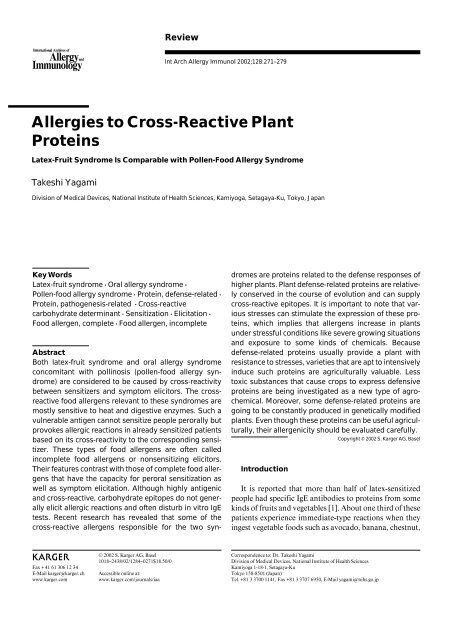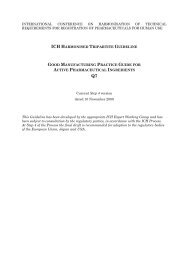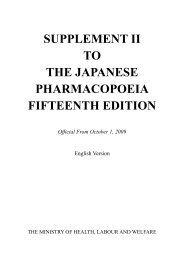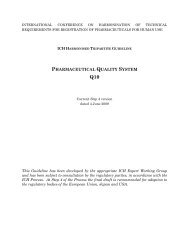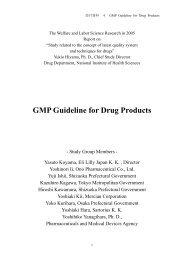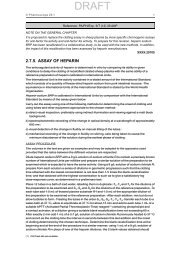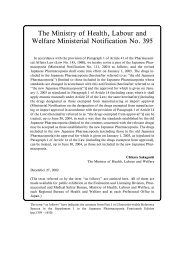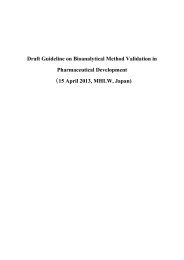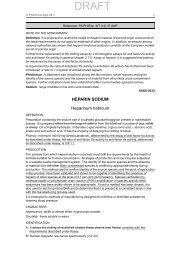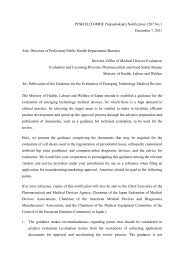Allergies to cross-reactive plant proteins. Latex-fruit ... - NIHS
Allergies to cross-reactive plant proteins. Latex-fruit ... - NIHS
Allergies to cross-reactive plant proteins. Latex-fruit ... - NIHS
Create successful ePaper yourself
Turn your PDF publications into a flip-book with our unique Google optimized e-Paper software.
Review<br />
Int Arch Allergy Immunol 2002;128:271–279<br />
<strong>Allergies</strong> <strong>to</strong> Cross-Reactive Plant<br />
Proteins<br />
<strong>Latex</strong>-Fruit Syndrome Is Comparable with Pollen-Food Allergy Syndrome<br />
Takeshi Yagami<br />
Division of Medical Devices, National Institute of Health Sciences, Kamiyoga, Setagaya-Ku, Tokyo, Japan<br />
Key Words<br />
<strong>Latex</strong>-<strong>fruit</strong> syndrome W Oral allergy syndrome W<br />
Pollen-food allergy syndrome W Protein, defense-related W<br />
Protein, pathogenesis-related W Cross-<strong>reactive</strong><br />
carbohydrate determinant W Sensitization W Elicitation W<br />
Food allergen, complete W Food allergen, incomplete<br />
Abstract<br />
Both latex-<strong>fruit</strong> syndrome and oral allergy syndrome<br />
concomitant with pollinosis (pollen-food allergy syndrome)<br />
are considered <strong>to</strong> be caused by <strong>cross</strong>-reactivity<br />
between sensitizers and symp<strong>to</strong>m elici<strong>to</strong>rs. The <strong>cross</strong><strong>reactive</strong><br />
food allergens relevant <strong>to</strong> these syndromes are<br />
mostly sensitive <strong>to</strong> heat and digestive enzymes. Such a<br />
vulnerable antigen cannot sensitize people perorally but<br />
provokes allergic reactions in already sensitized patients<br />
based on its <strong>cross</strong>-reactivity <strong>to</strong> the corresponding sensitizer.<br />
These types of food allergens are often called<br />
incomplete food allergens or nonsensitizing elici<strong>to</strong>rs.<br />
Their features contrast with those of complete food allergens<br />
that have the capacity for peroral sensitization as<br />
well as symp<strong>to</strong>m elicitation. Although highly antigenic<br />
and <strong>cross</strong>-<strong>reactive</strong>, carbohydrate epi<strong>to</strong>pes do not generally<br />
elicit allergic reactions and often disturb in vitro IgE<br />
tests. Recent research has revealed that some of the<br />
<strong>cross</strong>-<strong>reactive</strong> allergens responsible for the two syndromes<br />
are <strong>proteins</strong> related <strong>to</strong> the defense responses of<br />
higher <strong>plant</strong>s. Plant defense-related <strong>proteins</strong> are relatively<br />
conserved in the course of evolution and can supply<br />
<strong>cross</strong>-<strong>reactive</strong> epi<strong>to</strong>pes. It is important <strong>to</strong> note that various<br />
stresses can stimulate the expression of these <strong>proteins</strong>,<br />
which implies that allergens increase in <strong>plant</strong>s<br />
under stressful conditions like severe growing situations<br />
and exposure <strong>to</strong> some kinds of chemicals. Because<br />
defense-related <strong>proteins</strong> usually provide a <strong>plant</strong> with<br />
resistance <strong>to</strong> stresses, varieties that are apt <strong>to</strong> intensively<br />
induce such <strong>proteins</strong> are agriculturally valuable. Less<br />
<strong>to</strong>xic substances that cause crops <strong>to</strong> express defensive<br />
<strong>proteins</strong> are being investigated as a new type of agrochemical.<br />
Moreover, some defense-related <strong>proteins</strong> are<br />
going <strong>to</strong> be constantly produced in genetically modified<br />
<strong>plant</strong>s. Even though these <strong>proteins</strong> can be useful agriculturally,<br />
their allergenicity should be evaluated carefully.<br />
Introduction<br />
Copyright © 2002 S. Karger AG, Basel<br />
It is reported that more than half of latex-sensitized<br />
people had specific IgE antibodies <strong>to</strong> <strong>proteins</strong> from some<br />
kinds of <strong>fruit</strong>s and vegetables [1]. About one third of these<br />
patients experience immediate-type reactions when they<br />
ingest vegetable foods such as avocado, banana, chestnut,<br />
ABC<br />
Fax + 41 61 306 12 34<br />
E-Mail karger@karger.ch<br />
www.karger.com<br />
© 2002 S. Karger AG, Basel<br />
1018–2438/02/1284–0271$18.50/0<br />
Accessible online at:<br />
www.karger.com/journals/iaa<br />
Correspondence <strong>to</strong>: Dr. Takeshi Yagami<br />
Division of Medical Devices, National Institute of Health Sciences<br />
Kamiyoga 1-18-1, Setagaya-Ku<br />
Tokyo 158-8501 (Japan)<br />
Tel. +81 3 3700 1141, Fax +81 3 3707 6950, E-Mail yagami@nihs.go.jp
kiwi and pota<strong>to</strong> [2, 3]. This <strong>cross</strong>-reactivity is often called<br />
‘latex-<strong>fruit</strong> syndrome’ [1]. It has become evident that the<br />
latex-<strong>fruit</strong> syndrome is based on the <strong>cross</strong>-reactivity between<br />
latex allergens and antigens in the causative foods<br />
[4–6].<br />
On the other hand, it is well known that some pollenallergic<br />
patients also become allergic <strong>to</strong> certain kinds of<br />
fresh <strong>fruit</strong>s and vegetables as time passes. The offensive<br />
vegetable foods are usually not no<strong>to</strong>rious for their allergenicity.<br />
Because the specific symp<strong>to</strong>ms are usually restricted<br />
<strong>to</strong> the oral cavity, this type of food allergy has<br />
been collectively called ‘oral allergy syndrome’ (OAS) [7,<br />
8]. It has also been proposed that this particular food allergy<br />
should be called ‘pollen-food allergy syndrome’ [9],<br />
because OAS is a general term for allergic symp<strong>to</strong>ms limited<br />
<strong>to</strong> the oral cavity, and some patients experience OAS<br />
without pollinosis. Recent research has made it clearer<br />
that food allergies concomitant with pollinosis are based<br />
on the <strong>cross</strong>-reactivity between pollen allergens and antigens<br />
in vegetable foods [10–13].<br />
<strong>Latex</strong>-<strong>fruit</strong> syndrome is comparable <strong>to</strong> pollen-food allergy<br />
syndrome in several respects, including the processes<br />
from sensitization <strong>to</strong> symp<strong>to</strong>m elicitation and the<br />
relevant <strong>cross</strong>-<strong>reactive</strong> antigens. However, the severity of<br />
the allergic reactions in these syndromes is different <strong>to</strong><br />
some extent. In this article, the similarity of the two syndromes<br />
will be described from the viewpoint of the <strong>cross</strong><strong>reactive</strong><br />
antigens and their mode of action in symp<strong>to</strong>m<br />
manifestation.<br />
Cross-Reactive Antigens<br />
Immediate-type reactions are considered <strong>to</strong> be triggered<br />
by antigen-mediated <strong>cross</strong>-linking of IgE antibodies<br />
attached <strong>to</strong> the specific recep<strong>to</strong>r on the surface of a sensitized<br />
cell [14]. Without this <strong>cross</strong>-bridge formation between<br />
the IgE antibodies, allergic symp<strong>to</strong>ms are not provoked,<br />
even if an antigen is recognized by an IgE antibody<br />
on the membrane. The variable region of an IgE antibody<br />
does not interact with the whole of an antigenic protein.<br />
The variable region recognizes the partial structure (epi<strong>to</strong>pe)<br />
of an antigen that generally exists on the exterior.<br />
Therefore, an IgE antibody may not be able <strong>to</strong> distinguish<br />
structurally different antigens if they share the same epi<strong>to</strong>pe.<br />
This phenomenon underlies the <strong>cross</strong>-reactivity of<br />
IgE antibodies.<br />
As candidates of antigens containing a common epi<strong>to</strong>pe,<br />
we can imagine genetically conserved enzymes and<br />
<strong>proteins</strong> with interactive or binding properties [15]. The<br />
partial structures important for their enzymatic or binding<br />
activities tend <strong>to</strong> exist on the outside of a molecule.<br />
Moreover, these structures would not be mutated and<br />
therefore conserved in the course of evolution, regardless<br />
of the species. Extensive <strong>cross</strong>-reactivity is expected when<br />
such a conserved structure supplies epi<strong>to</strong>pes for IgE antibodies<br />
[16].<br />
At this stage, it is essential <strong>to</strong> differentiate peptidic epi<strong>to</strong>pes<br />
from carbohydrate epi<strong>to</strong>pes on glyco<strong>proteins</strong>. A<br />
protein or glycoprotein with peptidic epi<strong>to</strong>pes most likely<br />
acts as a multivalent antigen and forms a <strong>cross</strong>-bridge<br />
between the specific IgE antibodies attached <strong>to</strong> the surface<br />
of a sensitized cell [14]. Allergic reactions are actually<br />
triggered by this event. In contrast, carbohydrate epi<strong>to</strong>pes,<br />
except for some special cases [17, 18], act as monovalent<br />
antigens. Monovalent antigens cannot form the<br />
<strong>cross</strong>-bridge that is necessary for the occurrence of ensuing<br />
allergic symp<strong>to</strong>ms. In other words, carbohydrate epi<strong>to</strong>pes<br />
do not usually result in actual symp<strong>to</strong>ms, even<br />
though they are specifically recognized by IgE antibodies<br />
[19, 20]. In particular, we must pay attention <strong>to</strong> the cases<br />
where carbohydrate structures called complex-type glycans<br />
provide epi<strong>to</strong>pes for IgE antibodies [21, 22]. These<br />
epi<strong>to</strong>pes (carbohydrate <strong>cross</strong>-<strong>reactive</strong> determinants) are<br />
often seen on glyco<strong>proteins</strong> from <strong>plant</strong> and invertebrate<br />
tissues and probably bring about false-positive results on<br />
in vitro IgE tests that check <strong>cross</strong>-reactivity [23, 24]. The<br />
functional difference between the peptidic epi<strong>to</strong>pes and<br />
carbohydrate epi<strong>to</strong>pes described above sometimes confuses<br />
the interpretation of in vitro IgE tests that are<br />
applied daily in the diagnosis of immediate-type allergies<br />
[19–24].<br />
In in vitro IgE tests of a patient’s sera, the amount of<br />
IgE antibodies that specifically recognized antigens,<br />
which are fixed on a plate or disk, is determined. In particular,<br />
it is not the specific IgE antibodies attached <strong>to</strong> the<br />
recep<strong>to</strong>r of a sensitized cell that are being measured, but<br />
rather the free IgE antibodies in the sera. Antigen recognition<br />
by the free IgE antibodies in a patient’s serum does<br />
not directly reflect the following allergic reactions, even if<br />
the recognized antigen is multivalent. Moreover, we cannot<br />
distinguish the specific IgE antibodies <strong>to</strong> monovalent<br />
antigens from those <strong>to</strong> the multivalent antigens that are<br />
actually responsible for allergic reactions. If glyco<strong>proteins</strong><br />
occupy part of the fixed antigens, IgE antibodies specific<br />
<strong>to</strong> the monovalent carbohydrate epi<strong>to</strong>pes are detected<br />
simultaneously and bring about false-positive results. To<br />
make matters worse, IgE antibodies specific <strong>to</strong> carbohydrate<br />
<strong>cross</strong>-<strong>reactive</strong> determinants will result in a false-positive<br />
outcome with respect <strong>to</strong> <strong>cross</strong>-reactivity <strong>to</strong> various<br />
272 Int Arch Allergy Immunol 2002;128:271–279 Yagami
glyco<strong>proteins</strong> from <strong>plant</strong>s and invertebrates [19, 23, 24].<br />
These IgE tests might also show false-negative responses if<br />
the fixed antigens are unstable and easily lose their antigenicity,<br />
as described in the following section. In this way, in<br />
vitro IgE tests involve the inherent drawbacks of falsepositive<br />
or false-negative results, even though they are<br />
very convenient.<br />
We can investigate the relevance of an antigen <strong>to</strong> particular<br />
allergic reactions more directly using the skin prick<br />
test or the histamine release test. These diagnostic tests<br />
are not dis<strong>to</strong>rted by the specific IgE antibodies <strong>to</strong> monovalent<br />
antigens. Symp<strong>to</strong>matic <strong>cross</strong>-reactivity can also be<br />
evaluated by these methods without significant disturbances.<br />
However, the standardized antigen solution necessary<br />
for these tests is unavailable at present for many<br />
kinds of allergic sources. Moreover, allergens in fresh<br />
<strong>fruit</strong>s and vegetables are usually unstable and easily lose<br />
their antigenicity during s<strong>to</strong>rage [12, 25, 26]. False-negative<br />
results may be brought about by such expired antigens.<br />
Thus, each diagnostic test involves the inherent<br />
strong points and weak points. From the characteristics of<br />
each method, we can conclude that it is probably reasonable<br />
<strong>to</strong> reconfirm the results of in vitro IgE tests by the<br />
skin prick test or the histamine release test if there are<br />
uncertainties in the former test.<br />
In vitro IgE tests are often applied <strong>to</strong> the diagnoses of<br />
vegetable food allergies concomitant with latex allergy or<br />
pollinosis. We must always take in<strong>to</strong> consideration the<br />
possible false-positive or false-negative results in such a<br />
test, because antigens extracted from <strong>plant</strong> tissues ordinarily<br />
include glyco<strong>proteins</strong> and are inclined <strong>to</strong> readily<br />
lose their antigenicity [12, 26]. In addition, the antigen<br />
solution used in the skin prick test and the histamine<br />
release test should be prepared just before diagnosis <strong>to</strong><br />
ensure the relevance of the suspected vegetable foods <strong>to</strong><br />
the allergic reactions.<br />
Pan-Allergens<br />
Allergenic <strong>proteins</strong> responsible for extensive <strong>cross</strong>reactivity<br />
are often called ‘pan-allergens’. Profilin is a representative<br />
pan-allergen [27, 28]. It has an actin-binding<br />
property, and every eukaryotic cell contains structurally<br />
related profilin. Because of its structural conservatism,<br />
profilin can provide common epi<strong>to</strong>pes that are at the root<br />
of the extensive <strong>cross</strong>-reactivity. One of the reasons for<br />
the marked <strong>cross</strong>-reactivity of pollen-allergic patients <strong>to</strong><br />
various vegetable foods is the profilin present both in the<br />
pollen and in the offensive foods [12, 28]. Profilin in natu-<br />
Fig. 1. Defense-related <strong>proteins</strong> form families of <strong>cross</strong>-<strong>reactive</strong> <strong>plant</strong><br />
allergens.<br />
ral rubber latex, which is a cause of latex-<strong>fruit</strong> syndrome,<br />
was also officially registered as latex allergen Hev b 8 [29].<br />
Similarly, calcium-binding <strong>proteins</strong> from <strong>plant</strong>s contain a<br />
conserved structure. They were actually assigned <strong>to</strong> a<br />
family of <strong>cross</strong>-<strong>reactive</strong> <strong>plant</strong> allergens [30].<br />
Recently, it has been confirmed that a series of <strong>proteins</strong><br />
related <strong>to</strong> the defense responses of higher <strong>plant</strong>s<br />
organize new families of pan-allergens (fig. 1) [31–33].<br />
The defense mechanisms of higher <strong>plant</strong>s are relatively<br />
conserved in the course of evolution, and structurally<br />
related <strong>proteins</strong> are induced or accumulated in taxonomically<br />
distant <strong>plant</strong>s [34–37]. Some of the defense-related<br />
<strong>proteins</strong> strengthen the cell walls <strong>to</strong> protect the <strong>plant</strong>, and<br />
others are necessary for the biosynthesis of a low-molecular-weight<br />
antibiotic called phy<strong>to</strong>alexin [34]. For example,<br />
isoflavone reductase, which was reported as a minor<br />
<strong>cross</strong>-<strong>reactive</strong> allergen for birch-pollen-allergic patients<br />
[38, 39], is a defense-related protein that plays a part in<br />
the biosynthesis of phy<strong>to</strong>alexin [34]. Some kinds of lectin<br />
and s<strong>to</strong>rage albumin have antifungal activity and are also<br />
considered members of the defensive array of a <strong>plant</strong> [34,<br />
40, 41]. Moreover, it is becoming more and more evident<br />
that pathogenesis-related (PR) <strong>proteins</strong> form novel families<br />
of <strong>cross</strong>-<strong>reactive</strong> <strong>plant</strong> allergens [32, 33, 42–45]. They<br />
are a group of defense-related <strong>proteins</strong> that are specifically<br />
expressed following an attack of phy<strong>to</strong>pathogens [46, 47].<br />
PR <strong>proteins</strong> are now classified in<strong>to</strong> fourteen groups<br />
based on their sequence homology, serological or immunological<br />
relationships, and enzymatic activity [48, 49].<br />
Class I endochitinases, which are a major cause of <strong>cross</strong>-<br />
<strong>Allergies</strong> <strong>to</strong> Cross-Reactive Plant Proteins Int Arch Allergy Immunol 2002;128:271–279 273
eactivity between latex and vegetable foods [6], belong <strong>to</strong><br />
the PR-3 family. They commonly contain a hevein-related<br />
region in their N-termini [50, 51]. Hevein is an important<br />
latex allergen (Hev b 6.02) and provides several<br />
<strong>cross</strong>-<strong>reactive</strong> epi<strong>to</strong>pes [52, 53]. On the other hand, <strong>proteins</strong><br />
in the PR-4 family are homologous <strong>to</strong> the C-terminal<br />
region (Hev b 6.03) of prohevein (Hev b 6.01) [54, 55].<br />
Therefore, <strong>proteins</strong> classified in<strong>to</strong> the PR-4 families as<br />
well as in<strong>to</strong> the PR-3 family would participate in latex<strong>fruit</strong><br />
syndrome [6, 56]. Nonspecific lipid transfer <strong>proteins</strong><br />
(LTPs) occupy the PR-14 families [49]. An LTP from natural<br />
rubber latex was officially registered as latex allergen<br />
Hev b 12. Some vegetable food allergies without concurrent<br />
pollinosis are due <strong>to</strong> the <strong>cross</strong>-reactivity of LTPs in<br />
causative foods [57, 58].<br />
Proteins belonging <strong>to</strong> the PR-10 family are a key <strong>to</strong><br />
understanding OAS concomitant with pollinosis (pollenfood<br />
allergy syndrome). A major <strong>cross</strong>-<strong>reactive</strong> allergen<br />
(Bet v 1) in birch-pollen is induced by stresses and is classified<br />
as a member of this family [59–63]. Pollen from<br />
other trees such as elder, oak and chestnut also contains<br />
allergens with sequences that are homologous <strong>to</strong> those of<br />
PR-10 <strong>proteins</strong> [12, 33]. Furthermore, vegetable foods<br />
that often irritate birch-pollen-allergic patients produce<br />
and accumulate defensive <strong>proteins</strong> that may also be members<br />
of this family [64, 65]. By considering the homology<br />
among the antigens in pollen and vegetable foods, we can<br />
easily understand why pollen-allergic people, especially<br />
Bet v 1-sensitized patients, often <strong>cross</strong>-react <strong>to</strong> various<br />
taxonomically unrelated vegetable foods and pollen [66,<br />
67].<br />
Induction of Novel Plant Allergens<br />
Important <strong>cross</strong>-<strong>reactive</strong> allergens that are responsible<br />
for latex-<strong>fruit</strong> syndrome or pollen-food allergy syndrome<br />
are related <strong>to</strong> the defense responses of higher <strong>plant</strong>s [33].<br />
Some of the defense-related <strong>proteins</strong> are accumulated in<br />
seeds or <strong>fruit</strong>, and others are newly induced under stressful<br />
conditions [34]. Proteins in a s<strong>to</strong>rage organ usually<br />
change quantitatively and qualitatively according <strong>to</strong> the<br />
maturity of the organ. On the other hand, the defense<br />
responses are triggered by various fac<strong>to</strong>rs such as chemicals,<br />
heavy metals, pathogens, air pollutants, ultraviolet<br />
rays and severe growing conditions. It is reasonable <strong>to</strong><br />
speculate, then, that antigens in a <strong>plant</strong> tissue are changeable<br />
quantitatively and quantitatively (fig. 1) [68–74]. If<br />
this is the case, environmental pollution could be partly<br />
blamed for the increase in allergic disorders <strong>to</strong> <strong>plant</strong>s<br />
because some kinds of chemicals and air pollutants stimulate<br />
the defense responses. In fact, one report suggests the<br />
induction of a <strong>cross</strong>-<strong>reactive</strong> allergen (Bet v 1) in birch<br />
pollen by ozone and nitrogen dioxide [75, 76]. Another<br />
study revealed that the amounts of IgE-<strong>reactive</strong> antigens<br />
were increased up <strong>to</strong> 10 times by treating Brassica rapa<br />
with salicylic acid or ethephon, which are representative<br />
chemicals that stimulate the defense responses [77]. This<br />
finding is especially notable because such defense-response<br />
activating chemicals are being intensively investigated<br />
as a new type of agrochemical with less <strong>to</strong>xicity <strong>to</strong><br />
humans. The application of such substances might augment<br />
the amount of allergen in a <strong>plant</strong>. Extensive studies<br />
are urgently required <strong>to</strong> establish whether various chemicals<br />
and environmental pollutants have something <strong>to</strong> do<br />
with the recent prevalence of immediate-type allergies <strong>to</strong><br />
vegetable foods and pollen.<br />
Given the functions of defense-related <strong>proteins</strong>, it is<br />
clear that a <strong>plant</strong> producing a large amount of such <strong>proteins</strong><br />
would be resistant <strong>to</strong> stresses and therefore agriculturally<br />
advantageous [41, 47]. One aim of conventional<br />
<strong>plant</strong> breeding is actually <strong>to</strong> develop a new variety highly<br />
resistant <strong>to</strong> environmental stresses. However, a variety<br />
that produces a large amount of allergens might inadvertently<br />
be selected through such improvements. The variety<br />
dependencies of IgE-<strong>reactive</strong> <strong>proteins</strong> have already<br />
been reported for apple, paprika, rice and other food<br />
crops [65, 78–80]. Unfortunately, no exhaustive research<br />
has yet been done on the possible increase in allergens<br />
accompanying conventional <strong>plant</strong> breeding.<br />
Additionally, many researchers are trying <strong>to</strong> develop a<br />
stress-resistant variety by constantly expressing some<br />
kind of defense-related <strong>proteins</strong> using biotechnology [37,<br />
81, 82]. Again, one can readily imagine the increased<br />
allergenicity of the genetically modified <strong>plant</strong> [33]. These<br />
are remarkable examples where potentially allergenic <strong>proteins</strong><br />
were intentionally expressed in a <strong>plant</strong> [41, 47, 83,<br />
84]. It is important that newly developed <strong>plant</strong>s should be<br />
carefully evaluated for their safety. The allergenicity of a<br />
deliberately expressed protein must be evaluated from<br />
various points of view [85, 86]. As will be discussed in the<br />
next section, people cannot fully determine the allergenicity<br />
of a protein based solely on its stability <strong>to</strong> digestive<br />
enzymes [87]. An international consensus for the evaluation<br />
of the allergenicity of genetically modified <strong>plant</strong>s<br />
must be established [88].<br />
274 Int Arch Allergy Immunol 2002;128:271–279 Yagami
Complete Food Allergens and Incomplete Food<br />
Allergens<br />
It has been generally believed that food allergens are<br />
<strong>proteins</strong> that are resistant <strong>to</strong> heat and digestive enzymes.<br />
In actuality, significant stability in an artificial gastric<br />
fluid was reported for the major allergens in milk, eggs,<br />
soybeans, peanuts and others [89–91]. However, many of<br />
the allergens responsible for latex-<strong>fruit</strong> syndrome or pollen-food<br />
allergy syndrome are sensitive <strong>to</strong> heat and digestive<br />
enzymes [12, 92, 93]. The author’s group showed that<br />
most IgE-<strong>reactive</strong> antigens extracted from natural rubber<br />
latex and vegetable foods were digested in an artificial<br />
gastric fluid within a few minutes [87]. As a matter of fact,<br />
many patients suffering from pollen-food allergy syndrome<br />
can eat cooked vegetable foods without any allergic<br />
reaction [94]. It also has <strong>to</strong> be mentioned that the number<br />
of patients who are allergic only <strong>to</strong> fresh <strong>fruit</strong>s or vegetables<br />
is significantly smaller than the number of people suffering<br />
from latex-<strong>fruit</strong> syndrome and pollen-food allergy<br />
syndrome [16]. From these findings, we can rationally<br />
speculate that the food allergens responsible for these syndromes<br />
have considerably different properties from the<br />
conventional food allergens [33].<br />
It is traditionally postulated that only special food <strong>proteins</strong><br />
unaffected by cooking and digestive enzymes are<br />
absorbed from the intestine and recognized by the immune<br />
system <strong>to</strong> be a peroral sensitizer. After the establishment<br />
of peroral sensitization, generalized symp<strong>to</strong>ms are<br />
expected <strong>to</strong> be provoked whenever the patient ingests the<br />
same protein. In this sequential process of food allergy<br />
manifestation (type I food allergy), the same antigen plays<br />
a crucial role in both the sensitization and the symp<strong>to</strong>m<br />
elicitation (fig. 2). Such a food allergen that has the potential<br />
<strong>to</strong> cause peroral sensitization as well as peroral elicitation<br />
is often called a ‘complete food allergen’ [95, 96].<br />
In contrast <strong>to</strong> the conventional food allergies, sensitization<br />
is established through direct contact with latex products<br />
or through the inhalation of allergen-containing particles<br />
in the latex-<strong>fruit</strong> syndrome and the pollen-food<br />
allergy syndrome [11, 13, 57, 97]. Upon the completion of<br />
sensitization, allergic symp<strong>to</strong>ms are expected <strong>to</strong> be provoked<br />
by not only the second exposure <strong>to</strong> the same allergens<br />
but also by ingestion of vegetable foods containing<br />
the <strong>cross</strong>-<strong>reactive</strong> antigens (type II food allergy). In this<br />
sequential process, different antigens (a sensitizer and an<br />
elici<strong>to</strong>r) play a crucial role in the sensitization and the<br />
symp<strong>to</strong>m elicitation, respectively (fig. 2). The <strong>cross</strong>-<strong>reactive</strong><br />
antigens in foods are responsible only for the symp<strong>to</strong>m<br />
elicitation, and they have nothing <strong>to</strong> do with the sen-<br />
Fig. 2. Traditional food allergies (left) and food allergies based on the<br />
<strong>cross</strong>-reactivity between sensitizers and symp<strong>to</strong>m elici<strong>to</strong>rs (right).<br />
Digestible food <strong>proteins</strong> rarely establish peroral sensitization. However,<br />
they can cause allergic symp<strong>to</strong>ms, mainly OAS, in already sensitized<br />
patients based on their <strong>cross</strong>-reactivity <strong>to</strong> the corresponding<br />
sensitizers.<br />
sitization. Accordingly, these <strong>cross</strong>-<strong>reactive</strong> allergens do<br />
not usually have the properties required <strong>to</strong> establish peroral<br />
sensitization. Such a food allergen having the potential<br />
only <strong>to</strong> cause peroral elicitation is often called an ‘incomplete<br />
food allergen’ or a ‘nonsensitizing elici<strong>to</strong>r’ [95,<br />
96]. Incomplete food allergens provoke allergic reactions<br />
in already-sensitized patients based on their <strong>cross</strong>-reactivity<br />
<strong>to</strong> the corresponding sensitizers (fig. 2).<br />
By considering the mode of action of incomplete food<br />
allergens, we can easily explain why allergic reactions<br />
around the oral cavity (OAS) are the dominant manifestation<br />
of latex-<strong>fruit</strong> syndrome and pollen-food allergy syndrome<br />
[33]. Incomplete food allergens are mostly digestible<br />
[87]. Therefore, they rapidly lose their antigenicity<br />
after reaching the digestive organs, although they retain it<br />
in the oral cavity (fig. 3). The instability of incomplete<br />
food allergens <strong>to</strong> heat also accounts for the declined allergenicity<br />
of cooked vegetables [26, 74, 94].<br />
The most noticeable difference between latex-<strong>fruit</strong> syndrome<br />
and pollen-food allergy syndrome is the severity of<br />
the symp<strong>to</strong>ms caused by offensive foods. The majority of<br />
food allergies concomitant with pollinosis are limited <strong>to</strong><br />
the oral cavity (OAS), but latex-sensitized patients sometimes<br />
experience generalized symp<strong>to</strong>ms in addition <strong>to</strong><br />
OAS [2, 3]. The author’s group showed that hevein<br />
(4.7 kD) was exceptionally stable in an artificial gastric<br />
fluid [87]. Hevein includes common epi<strong>to</strong>pes relevant <strong>to</strong><br />
<strong>Allergies</strong> <strong>to</strong> Cross-Reactive Plant Proteins Int Arch Allergy Immunol 2002;128:271–279 275
Fig. 3. Diverse allergenicity of food antigens.<br />
For efficient peroral sensitization, stability<br />
<strong>to</strong> digestive enzymes and a molecular<br />
weight larger than LTPs would be required.<br />
Profilin and the hevein-related regions of<br />
class I endochitinases are most likely incomplete<br />
food allergens (nonsensitizing elici<strong>to</strong>rs).<br />
They are expected <strong>to</strong> cause symp<strong>to</strong>ms<br />
from OAS <strong>to</strong> anaphylaxis in already sensitized<br />
patients, depending on their stability <strong>to</strong><br />
heat and digestive enzymes. Drawings show<br />
the representative features of each group.<br />
the <strong>cross</strong>-reactivity between latex and vegetable foods<br />
such as avocado, banana and chestnut [6, 53]. However,<br />
few people claim <strong>to</strong> have allergic reactions only <strong>to</strong> these<br />
vegetable foods without a concomitant latex allergy [98].<br />
Taken <strong>to</strong>gether, these findings suggest that the heveinrelated<br />
regions of <strong>cross</strong>-<strong>reactive</strong> food allergens are resistant<br />
<strong>to</strong> digestion and are absorbed from the intestine, but<br />
they are <strong>to</strong>o small <strong>to</strong> sensitize people. Nevertheless, they<br />
can cause generalized symp<strong>to</strong>ms for a patient who has<br />
already been sensitized by hevein or a protein containing<br />
a hevein-related region through inhalation or direct contact<br />
(fig. 3) [33].<br />
Here it must be emphasized that the differentiation<br />
between complete food allergens and incomplete food<br />
allergens mentioned above is relative and presupposes the<br />
digestion of healthy adults. For patients with gastrointestinal<br />
disease and for young children, even food <strong>proteins</strong><br />
that are easily digested in the normal adult gut may act as<br />
peroral sensitizers and elici<strong>to</strong>rs of generalized symp<strong>to</strong>ms<br />
[95]. In addition, manifestations of allergic reactions may<br />
be modified by the physiological stresses of a patient and<br />
concurrent medication. It is well-known that some people<br />
experience food-dependent exercise-induced anaphylaxis<br />
[99] and others suffer from food allergies following the<br />
administration of certain medicine [100, 101]. The actual<br />
allergenicity of an antigen, therefore, depends not only on<br />
the nature of the protein but also on the status of the individual.<br />
Perspectives<br />
Researchers have accepted the general concept that<br />
there are allergens specific <strong>to</strong> each exposure route and that<br />
they cause allergic reactions independently. This concept<br />
presupposes the identity of the antigens responsible for<br />
sensitization and for symp<strong>to</strong>m elicitation. In latex-<strong>fruit</strong><br />
syndrome and pollen-food allergy syndrome, however,<br />
the elici<strong>to</strong>rs are molecules that are distinct from the sensitizers<br />
and provoke allergic symp<strong>to</strong>ms based on their<br />
<strong>cross</strong>-reactivity <strong>to</strong> the corresponding sensitizers. Because<br />
the <strong>cross</strong>-reactivity is the sole prerequisite for becoming a<br />
symp<strong>to</strong>m elici<strong>to</strong>r, we must take in<strong>to</strong> consideration cases<br />
where the exposure routes <strong>to</strong> a sensitizer and an elici<strong>to</strong>r<br />
are different (fig. 2) [33]. The advent of the idea that allergic<br />
reactions caused by the <strong>cross</strong>-reactivity between a sensitizer<br />
and an elici<strong>to</strong>r might bring about discussions of<br />
which antigens should be called allergens: sensitizers,<br />
symp<strong>to</strong>m elici<strong>to</strong>rs, or both.<br />
Many proteinaceous allergens have been identified<br />
from various sources in recent years. However, no decisive<br />
common features can be drawn from the official list<br />
of proteinaceous allergens [96]. This implies that most<br />
<strong>proteins</strong> can become allergens if specific conditions are<br />
met, including exposure routes, amounts of antigens, frequency<br />
of exposure or <strong>cross</strong>-reactivity. Conventional food<br />
allergens were, indeed, confined <strong>to</strong> <strong>proteins</strong> that are stable<br />
<strong>to</strong> heat and digestive enzymes (complete food allergens)<br />
[89, 90]. We can now interpret this his<strong>to</strong>rical fact as<br />
meaning that ingestion was the only important exposure<br />
276 Int Arch Allergy Immunol 2002;128:271–279 Yagami
oute <strong>to</strong> the sensitizers. If a person is sensitized through<br />
other exposure routes, for example, through the inhalation<br />
of pollen and allergen-adsorbing powder, many <strong>cross</strong><strong>reactive</strong><br />
food <strong>proteins</strong> become candidates for novel food<br />
allergens (incomplete food allergens) [33]. It is possible<br />
that the recent prevalence of vegetable food allergies in<br />
the adult population is attendant on the increasing tendency<br />
<strong>to</strong>ward pollinosis [86].<br />
Some defense-related <strong>proteins</strong> in <strong>plant</strong>s are responsible<br />
for latex-<strong>fruit</strong> syndrome and pollen-food allergy syndrome<br />
[33]. They can be induced by conventional or biotechnological<br />
<strong>plant</strong> breeding as well as by chemicals and<br />
environmental pollutants (fig. 1). On the other hand, we<br />
are exposed <strong>to</strong> proteinaceous sensitizers through various<br />
routes including ingestion, inhalation and direct contact.<br />
Allergic disorders have steadily been increasing for a long<br />
time, but the real reason for this increment is still obscure.<br />
The changes in the susceptibility of human beings have<br />
been well documented; however, the quantitative increase<br />
and the changes in allergenic <strong>proteins</strong> as well as the expansion<br />
of exposure routes <strong>to</strong> sensitizers may be other fac<strong>to</strong>rs<br />
that have been overlooked.<br />
Acknowledgment<br />
The author thanks Dr. Hirohisa Sai<strong>to</strong> (National Research Institute<br />
for Child Health and Development, Japan) for his helpful comments<br />
and encouragement.<br />
References<br />
1 Brehler R, Theissen U, Mohr C, Luger T: ‘<strong>Latex</strong>-<strong>fruit</strong><br />
syndrome’: Frequency of <strong>cross</strong>-reacting<br />
IgE antibodies. Allergy 1997;52:404–410.<br />
2 Lavaud F, Sabouraud D, Deschamps F, Perdu<br />
D: Crossreactions involving natural rubber latex.<br />
Clin Rev Allergy Immunol 1997;15:429–<br />
447.<br />
3 Raulf-Heimsoth M, Posch A, Chen Z, Baur X:<br />
Cross-reactivity between natural rubber latex<br />
and food allergens. Environ Toxicol Pharmacol<br />
1997;4:169–173.<br />
4 Posch A, Chen Z, Raulf-Heimsoth M, Baur X:<br />
<strong>Latex</strong> allergens. Clin Exp Allergy 1998;28:134–<br />
140.<br />
5 Nel A, Gujuluva C: <strong>Latex</strong> antigens: Identification<br />
and use in clinical and experimental studies,<br />
including <strong>cross</strong>reactivity with food and<br />
pollen allergens. Ann Allergy Asthma Immunol<br />
1998;81:388–398.<br />
6 Salcedo G, Díaz-Perales A, Sánchez-Monge R:<br />
Fruit allergy: Plant defence <strong>proteins</strong> as novel<br />
potential panallergens. Clin Exp Allergy 1999;<br />
29:1158–1160.<br />
7 Vickerstaff Joneja JM: Oral allergy syndrome,<br />
<strong>cross</strong>-reacting allergens and co-occurring allergies.<br />
J Nutr Environ Med 1999;9:289–303.<br />
8 Sloane D, Sheffer A: Oral allergy syndrome.<br />
Allergy Asthma Proc 2001;22:321–325.<br />
9 Kelso JM: Pollen-food allergy syndrome. Clin<br />
Exp Allergy 2000;30:905–907.<br />
10 Aalberse RC: Clinically significant <strong>cross</strong>-reactivities<br />
among allergens. Int Arch Allergy Immunol<br />
1992;99:261–264.<br />
11 Valenta R, Kraft D: Type I allergic reactions <strong>to</strong><br />
<strong>plant</strong>-derived food: A consequence of primary<br />
sensitization <strong>to</strong> pollen allergens. J Allergy Clin<br />
Immunol 1996;97:893–895.<br />
12 Vieths S: Allergenic <strong>cross</strong>-reactivity, food allergy<br />
and pollen. Environ Toxicol Pharmacol<br />
1997;4:61–70.<br />
13 Kazemi-Shirazi L, Pauli G, Purohit A, Spitzauer<br />
S, Fröschl R, Hoffmann-Sommergruber<br />
K, Breiteneder H, Scheiner O, Kraft D, Valenta<br />
R: Quantitataive IgE inhibition experiments<br />
with purified recombinant allergens indicate<br />
pollen-derived allergens as the sensitizing<br />
agents responsible for many forms of <strong>plant</strong><br />
food allergy. J Allergy Clin Immunol 2000;105:<br />
116–125.<br />
14 Huby RDJ, Dearman RJ, Kimber I: Why are<br />
some <strong>proteins</strong> allergens Toxicol Sci 2000;55:<br />
235–246.<br />
15 Vuit<strong>to</strong>n DA: Allergic <strong>cross</strong>reactions. Clin Rev<br />
Allergy Immunol 1997;15:367–374.<br />
16 Sicherer SH: Clinical implications of <strong>cross</strong><strong>reactive</strong><br />
food allergens. J Allergy Clin Immunol<br />
2001;108:881–890.<br />
17 Batanero E, Crespo JF, Monsalve RI, Martín-<br />
Esteban M, Villalba M, Rodríguez R: IgE-binding<br />
and histamine-release capabilities of the<br />
main carbohydrate component isolated from<br />
the major allergen of olive tree pollen, Ole e 1. J<br />
Allergy Clin Immunol 1999;103:147–153.<br />
18 Fötisch K, Altmann F, Haustein D, Vieths S:<br />
Involvement of carbohydrate epi<strong>to</strong>pes in the<br />
IgE responses of celery-allergic patients. Int<br />
Arch Allergy Immunol 1999;120:30–42.<br />
19 van der Veen MJ, van Ree R, Aalberse RC,<br />
Akkerdaas J, Koppelman SJ, Jansen HM, van<br />
der Zee JS: Poor biologic activity of <strong>cross</strong>-<strong>reactive</strong><br />
IgE directed <strong>to</strong> carbohydrate determinants<br />
of glyco<strong>proteins</strong>. J Allergy Clin Immunol 1997;<br />
100:327–334.<br />
20 Aalberse RC: Clinical relevance of carbohydrate<br />
allergen epi<strong>to</strong>pes. Allergy 1998;53:54–<br />
57.<br />
21 Aalberse RC, van Ree R: Cross<strong>reactive</strong> carbohydrate<br />
determinants. Clin Rev Allergy Immunol<br />
1997;15:375–387.<br />
22 van Ree R, Cabanes-Macheteau M, Akkerdaas<br />
J, Milazzo J-P, Loutelier-Bourhis C, Rayon C,<br />
Villalba M, Koppelman S, Aalberse R, Rodriguez<br />
R, Faye L, Lerouge P: ß(1,2)-Xylose and<br />
·(1,3)-fucose residues have a strong contribution<br />
in IgE binding <strong>to</strong> <strong>plant</strong> glycoallergens. J<br />
Biol Chem 2000;275:11451–11458.<br />
23 Bircher AJ, van Melle G, Haller E, Curty B,<br />
Frei PC: IgE <strong>to</strong> food allergens are highly prevalent<br />
in patients allergic <strong>to</strong> pollens, with and<br />
without symp<strong>to</strong>ms of food allergy. Clin Exp<br />
Allergy 1994;24:367–374.<br />
24 Mari A, Iacovacci P, Afferni C, Barletta B,<br />
Tinghino R, di Felice G, Pini C: Specific IgE<br />
<strong>to</strong> <strong>cross</strong>-<strong>reactive</strong> carbohydrate determinants<br />
strongly affect the in vitro diagnosis of allergic<br />
diseases. J Allergy Clin Immunol 1999;103:<br />
1005–1011.<br />
25 Pas<strong>to</strong>rello EA, Incorvaia C, Pravet<strong>to</strong>ni V, Farioli<br />
L, Conti A, Viganò G, Rivolta F, Ispano M,<br />
Ro<strong>to</strong>ndo F, Or<strong>to</strong>lani C: New allergens in <strong>fruit</strong>s<br />
and vegetables. Allergy 1998;53(suppl 46):48–<br />
51.<br />
26 Vieths S, Hoffmann A, Holzhauser T, Müller<br />
U, Reindl J, Haustein D: Fac<strong>to</strong>rs influencing<br />
the quality of food extracts for in vitro and in<br />
vivo diagnosis. Allergy 1998;53(suppl 46):65–<br />
71.<br />
27 Valenta R, Duchêne M, Pettenburger K, Sillaber<br />
C, Valent P, Bettelheim P, Breitenbach M,<br />
Rumpold H, Kraft D, Scheiner O: Identification<br />
of profilin as a novel pollen allergen;<br />
IgE au<strong>to</strong>reactivity in sensitized individuals.<br />
Science 1991;253:557–560.<br />
28 Valenta R, Duchene M, Ebner C, Valent P,<br />
Sillaber C, Deviller P, Ferreira F, Tejkl M,<br />
Edelmann H, Kraft D, Scheiner O: Profilins<br />
constitute a novel family of functional <strong>plant</strong><br />
pan-allergens. J Exp Med 1992;175:377–385.<br />
29 Ganglberger E, Radauer C, Wagner S, Riordain<br />
G, Beezhold DH, Brehler R, Niggemann B,<br />
Scheiner O, Jensen-Jarolim E, Breiteneder H:<br />
Hev b 8, the Hevea brasiliensis latex profilin, is<br />
a <strong>cross</strong>-<strong>reactive</strong> allergen of latex, <strong>plant</strong> foods<br />
and pollen. Int Arch Allergy Immunol 2001;<br />
125:216–227.<br />
<strong>Allergies</strong> <strong>to</strong> Cross-Reactive Plant Proteins Int Arch Allergy Immunol 2002;128:271–279 277
30 Valenta R, Hayek B, Seiberler S, Bugajska-<br />
Schretter A, Niederberger V, Twardosz A, Natter<br />
S, Vangelista L, Pas<strong>to</strong>re A, Spitzauer S,<br />
Kraft D: Calcium-binding allergens: From<br />
<strong>plant</strong>s <strong>to</strong> man. Int Arch Allergy Immunol 1998;<br />
117:160–166.<br />
31 Yagami T, Sa<strong>to</strong> M, Nakamura A, Komiyama<br />
T, Kitagawa K, Akasawa A, Ikezawa Z: Plant<br />
defense-related enzymes as latex antigens. J<br />
Allergy Clin Immunol 1998;101:379–385.<br />
32 Yagami T: Plant defense-related <strong>proteins</strong> and<br />
latex allergy. Environ Derma<strong>to</strong>l 1998;5(suppl<br />
2):31–39.<br />
33 Yagami T: Defense-related <strong>proteins</strong> as families<br />
of <strong>cross</strong>-<strong>reactive</strong> <strong>plant</strong> allergens. Recent Res<br />
Dev Allergy Clin Immunol 2000;1:41–64.<br />
34 Bowles DJ: Defense-related <strong>proteins</strong> in higher<br />
<strong>plant</strong>s. Annu Rev Biochem 1990;59:873–907.<br />
35 Kombrink E, Somssich IE: Defense responses<br />
of <strong>plant</strong>s <strong>to</strong> pathogens. Adv Bot Res 1995;21:<br />
1–34.<br />
36 Maleck K, Law<strong>to</strong>n K: Plant strategies for resistance<br />
<strong>to</strong> pathogens. Curr Opin Biotechnol<br />
1998;9:208–213.<br />
37 Fritig B, Heitz T, Legrand M: Antimicrobial<br />
<strong>proteins</strong> in induced <strong>plant</strong> defense. Curr Opin<br />
Immunol 1998;10:16–22.<br />
38 Vieths S, Frank E, Scheurer S, Meyer HE,<br />
Hrazdina G, Haustein D: Characterization of a<br />
new IgE-binding 35-kD protein from birch<br />
pollen with <strong>cross</strong>-reacting homologues in various<br />
<strong>plant</strong> foods. Scand J Immunol 1998;47:<br />
263–272.<br />
39 Karamloo F, Schmitz N, Scheurer S, Foetisch<br />
K, Hoffmann A, Haustein D, Vieths S: Molecular<br />
cloning and characterization of a birch pollen<br />
minor allergen, Bet v 5, belonging <strong>to</strong> a family<br />
of isoflavone reductase-related <strong>proteins</strong>. J<br />
Allergy Clin Immunol 1999;104:991–999.<br />
40 Peumans WJ, van Damme EJM: Lectins as<br />
<strong>plant</strong> defense <strong>proteins</strong>. Plant Physiol 1995;109:<br />
347–352.<br />
41 Shewry PR, Lucas JA: Plant <strong>proteins</strong> that confer<br />
resistance <strong>to</strong> pests and pathogens. Adv Bot<br />
Res 1997;26:135–192.<br />
42 Breiteneder H, Ebner C: Molecular and biochemical<br />
classification of <strong>plant</strong>-derived food<br />
allergens. J Allergy Clin Immunol 2000;106:<br />
27–36.<br />
43 Hoffmann-Sommergruber K: Plant allergens<br />
and pathogenesis-related <strong>proteins</strong>. Int Arch Allergy<br />
Immunol 2000;122:155–166.<br />
44 Midoro-Horiuti T, Brooks EG, Goldblum RM:<br />
Pathogenesis-related <strong>proteins</strong> of <strong>plant</strong>s as allergens.<br />
Ann Allergy Asthma Immunol 2001;87:<br />
261–271.<br />
45 Ebner C, Hoffmann-Sommergruber K, Breiteneder<br />
H: Plant food allergens homologous <strong>to</strong><br />
pathogenesis-related <strong>proteins</strong>. Allergy 2001;<br />
56(suppl 67):43–44.<br />
46 Stintzi A, Heitz T, Prasad V, Wiedemann-Merdinoglu<br />
S, Kauffmann S, Geoffroy P, Legrand<br />
M, Fritig B: Plant ‘pathogenesis-related’ <strong>proteins</strong><br />
and their role in defense against pathogens.<br />
Biochimie 1993;75:687–706.<br />
47 Yun DJ, Bressan RA, Hasegawa PM: Plant<br />
antifungal <strong>proteins</strong>. Plant Breed Rev 1997;14:<br />
39–88.<br />
48 van Loon LC, Pierpoint WS, Boller T, Conejero<br />
V: Recommendations for naming <strong>plant</strong><br />
pathogenesis-related <strong>proteins</strong>. Plant Mol Biol<br />
Rep 1994;12:245–264.<br />
49 van Loon LC, van Strien EA: The families of<br />
pathogenesis-related <strong>proteins</strong>, their activities,<br />
and comparative analysis of PR-1 type <strong>proteins</strong>.<br />
Physiol Mol Plant Pathol 1999;55:85–<br />
97.<br />
50 Raikhel NV, Lee H-I, Broekaert WF: Structure<br />
and function of chitin-binding <strong>proteins</strong>. Annu<br />
Rev Plant Physiol Plant Mol Biol 1993;44:<br />
591–615.<br />
51 Graham LS, Sticklen MB: Plant chitinases.<br />
Can J Bot 1994;72:1057–1083.<br />
52 van Parijs J, Broekaert WF, Goldstein IJ, Peumans<br />
WJ: Hevein: An antifungal protein from<br />
rubber-tree (Hevea brasiliensis) latex. Planta<br />
1991;183:258–264.<br />
53 Beezhold DH, Kostyal DA, Sussman GL: IgE<br />
epi<strong>to</strong>pe analysis of the hevein preprotein; a<br />
major latex allergen. Clin Exp Immunol 1997;<br />
108:114–121.<br />
54 Friedrich L, Moyer M, Ward E, Ryals J: Pathogenesis-related<br />
protein 4 is structurally homologous<br />
<strong>to</strong> the carboxy-terminal domains of hevein,<br />
Win-1 and Win-2. Mol Gen Genet 1991;<br />
230:113–119.<br />
55 Alenius H, Kalkkinen N, Lukka M, Reunala T,<br />
Turjanmaa K, Mäkinen-Kiljunen S, Yip E, Palosuo<br />
T: Prohevin from the rubber tree (Hevea<br />
brasiliensis) is a major latex allergen. Clin Exp<br />
Allergy 1995;24:659–665.<br />
56 Hänninen A-R, Kalkkinen N, Mikkola JH, Helin<br />
J, Turjanmaa K, Reunala T, Palosuo T: Prohevin-like<br />
defense protein of <strong>to</strong>bacco is a <strong>cross</strong><strong>reactive</strong><br />
allergen for latex-allergic patients. J<br />
Allergy Clin Immunol 2000;106:778–779.<br />
57 Pas<strong>to</strong>rello EA, Pravet<strong>to</strong>ni V, Farioli L, Ispano<br />
M, Fortuna<strong>to</strong> D, Monza M, Giuffrida MG,<br />
Rivolta F, Scibola E, Ansaloni R, Incorvaia C,<br />
Conti A, Or<strong>to</strong>lani C: Clinical role of a lipid<br />
transfer protein that acts as a new apple-specific<br />
allergen. J Allergy Clin Immunol 1999;<br />
104:1099–1106.<br />
58 Asero R, Mistrello G, Roncarolo D, de Vries<br />
SC, Gautier M-F, Ciurana CLF, Verbeek E,<br />
Mohammadi T, Knul-Brettlova V, Akkerdaas<br />
JH, Bulder I, Aalberse RC, van Ree R: Lipid<br />
transfer protein: A pan-allergen in <strong>plant</strong>-derived<br />
foods that is highly resistant <strong>to</strong> pepsin<br />
digestion. Int Arch Allergy Immunol 2000;122:<br />
20–32.<br />
59 Breiteneder H, Pettenburger K, Bi<strong>to</strong> A, Valenta<br />
R, Kraft D, Rumpold H, Scheiner O, Breitenbach<br />
M: The gene coding for the major birch<br />
pollen allergen Bet v I is highly homologous <strong>to</strong> a<br />
pea disease resistance response gene. EMBO J<br />
1989;8:1935–1938.<br />
60 Swoboda I, Scheiner O, Heberle-Bors E, Vicente<br />
O: cDNA cloning and characterization of<br />
three genes in the Bet v 1 gene family that<br />
encode pathogenesis-related <strong>proteins</strong>. Plant<br />
Cell Environ 1995;18:865–874.<br />
61 Swoboda I, Hoffmann-Sommergruber K,<br />
O’Ríordáin G, Scheiner O, Heberle-Bors E, Vicente<br />
O: Bet v 1 <strong>proteins</strong>, the major birch pollen<br />
allergens and members of a family of conserved<br />
pathogenesis-related <strong>proteins</strong>, show ribonuclease<br />
activity in vitro. Physiol Plant<br />
1996;96:433–438.<br />
62 Bufe A, Spangfort MD, Kahlert H, Schlaak M,<br />
Becker W-M: The major birch pollen allergen,<br />
Bet v 1, shows ribonuclease activity. Planta<br />
1996;199:413–415.<br />
63 Poupard P, Strullu D-G, Simoneau P: Two<br />
members of the Bet v 1 gene family encoding<br />
birch pathogenesis-related <strong>proteins</strong> display different<br />
patterns of root expression and woundinducibility.<br />
Aust J Plant Physiol 1998;25:459–<br />
464.<br />
64 Schöning B, Vieths S, Petersen A, Baltes W:<br />
Identification and characterization of allergens<br />
related <strong>to</strong> Bet v I, the major birch pollen allergen,<br />
in apple, cherry, celery and carrot by twodimensional<br />
immunoblotting and N-terminal<br />
microsequencing. J Sci Food Agric 1995;67:<br />
431–440.<br />
65 Son DY, Scheurer S, Hoffmann A, Haustein D,<br />
Vieths S: Pollen-related food allergy: Cloning<br />
and immunological analysis of isoforms and<br />
mutants of Mal d 1, the major apple allergen,<br />
and Bet v 1, the major birch pollen allergen.<br />
Eur J Nutr 1999;38:201–215.<br />
66 Fritsch R, Ebner C, Kraft D: Allergenic <strong>cross</strong>reactivities.<br />
Clin Rev Allergy Immunol 1997;<br />
15:397–404.<br />
67 Deviller P, Pauli G: Crossreactions involving<br />
<strong>plant</strong> allergens. Clin Rev Allergy Immunol<br />
1997;15:405–413.<br />
68 Broekaert W, Lee H-I, Kush A, Chua N-H,<br />
Raikhel N: Wound-induced accumulation of<br />
mRNA containing a hevein sequence in laticifers<br />
of rubber tree (Hevea brasiliensis). Proc<br />
Natl Acad Sci USA 1990;87:7633–7637.<br />
69 Kush A, Goyvaerts E, Chye M-L, Chua N-H:<br />
Laticifer-specific gene expression in Hevea brasiliensis<br />
(rubber tree). Proc Natl Acad Sci USA<br />
1990;87:1787–1790.<br />
70 d’Auzac J, Bouteau F, Chrestin H, Clément A,<br />
Jacob JL, Lacrotte R, Prévot JC, Pujade-Renaud<br />
V, Rona JP: Stress ethylene in Hevea brasiliensis:<br />
Physiological, cellular and molecular<br />
aspects. Curr Plant Sci Biotechnol Agric 1993;<br />
16:205–210.<br />
71 Chrestin H, Gidrol X, Kush A: Towards a latex<br />
molecular diagnostic of yield potential and the<br />
genetic engineering of the rubber tree. Euphytica<br />
1997;96:77–82.<br />
72 Midoro-Horiuti T, Goldblum RM, Kurosky A,<br />
Wood TG, Brooks EG: Variable expression of<br />
pathogenesis-related protein allergen in mountain<br />
cedar (Juniperus ashei) pollen. J Immunol<br />
2000;164:2188–2192.<br />
73 Pühringer H, Moll D, Hoffmann-Sommergruber<br />
K, Watillon B, Katinger H, da Câmara<br />
Machado ML: The promoter of an apple Ypr10<br />
gene, encoding the major allergen Mal d 1, is<br />
stress- and pathogen-inducible. Plant Sci 2000;<br />
152:35–50.<br />
278 Int Arch Allergy Immunol 2002;128:271–279 Yagami
74 Sánchez-Monge R, Blanco C, Perales AD, Collada<br />
C, Carrillo T, Aragoncillo C, Salcedo G:<br />
Class I chitinases, the panallergens responsible<br />
for the latex-<strong>fruit</strong> syndrome, are induced by<br />
ethylene treatment and inactivated by heating.<br />
J Allergy Clin Immunol 2000;106:190–195.<br />
75 Thomas P, Strube D, Valenta R, Przybilla B:<br />
Altered histamine releasing capacity (HRC) of<br />
pollutant-exposed birch pollen (BP) (abstract).<br />
J Allergy Clin Immunol 1998;101:S203.<br />
76 Masuch GI, Franz JT, Schoene K, Musken H,<br />
Bergmann KC: Ozone increases group 5 allergen<br />
content of Lolium perenne. Allergy 1997;<br />
52:874–875.<br />
77 Hänninen A-R, Mikkola JH, Kalkkinen N,<br />
Turjanmaa K, Ylitalo L, Reunala T, Palosuo T:<br />
Increased allergen production in turnip (Brassica<br />
rapa) by treatments activating defense<br />
mechanisms. J Allergy Clin Immunol 1999;<br />
104:194–201.<br />
78 Hsieh LS, Moos M Jr, Lin Y: Characterization<br />
of apple 18 and 31 kd allergens by microsequencing<br />
and evaluation of their content during<br />
s<strong>to</strong>rage and ripening. J Allergy Clin Immunol<br />
1995;96:960–970.<br />
79 Jensen-Jarolim E, Santner B, Leitner A,<br />
Grimm R, Scheiner O, Ebner C, Breiteneder H:<br />
Bell peppers (Capsicum annuum) express allergens<br />
(profilin, pathogenesis-related protein P23<br />
and Bet v 1) depending on the horticultural<br />
strain. Int Arch Allergy Immunol 1998;116:<br />
103–109.<br />
80 Kwaasi AAA, Harfi HA, Parhar RS, Collison<br />
KS, Al-Sedairy ST, Al-Mohanna FA: Cultivarspecific<br />
IgE-epi<strong>to</strong>pes in date (Phoenix dactylifera<br />
L.) <strong>fruit</strong> allergy. Correlation of skin test<br />
reactivity and IgE-binding properties in selecting<br />
date cultivars for allergen standardization.<br />
Int Arch Allergy Immunol 2000;123:137–144.<br />
81 Shah DM: Genetic engineering for fungal and<br />
bacterial diseases. Curr Opin Biotechnol 1997;<br />
8:208–214.<br />
82 García-Olmedo F, Molina A, Alamillo JM, Rodríguez-Palenzuéla<br />
P: Plant defense peptides.<br />
Biopolymers 1998;47:479–491.<br />
83 Jongedijk E, Tigelaar H, van Roekel JSC, Bres-<br />
Vloemans SA, Dekker I, van den Elzen PJM,<br />
Cornelissen BJC, Melchers LS: Synergistic activity<br />
of chitinases and ß-1,3-glucanases enhances<br />
fungal resistance in transgenic <strong>to</strong>ma<strong>to</strong><br />
<strong>plant</strong>s. Euphytica 1995;85:173–180.<br />
84 Lee H-I, Raikhel NV: Prohevein is poorly processed<br />
but shows enhanced resistance <strong>to</strong> a chitin-binding<br />
fungus in transgenic <strong>to</strong>ma<strong>to</strong> <strong>plant</strong>s.<br />
Braz J Med Biol Res 1995;28:743–750.<br />
85 Wal JM, Pascal G: Benefits and limits of different<br />
approaches for assessing the allergenic potential<br />
of novel foods. Allergy 1998;53(suppl<br />
46):98–101.<br />
86 Wal JM: Assessment of allergic potential of<br />
(novel) foods. Nahrung 1999;43:168–174.<br />
87 Yagami T, Haishima Y, Nakamura A, Osuna<br />
H, Ikezawa Z: Digestibility of allergens extracted<br />
from natural rubber latex and vegetable<br />
foods. J Allergy Clin Immunol 2000;106:752–<br />
762.<br />
88 Taylor SL: Protein allergenicity assessment of<br />
foods produced through agricultural biotechnology.<br />
Annu Rev Pharmacol Toxicol 2002;42:<br />
99–112.<br />
89 Astwood JD, Fuchs RL: Allergenicity of foods<br />
derived from transgenic <strong>plant</strong>s. Monogr Allergy<br />
1996;32:105–120.<br />
90 Astwood JD, Leach JN, Fuchs RL: Stability of<br />
food allergens <strong>to</strong> digestion in vitro. Nat Biotechnol<br />
1996;14:1269–1273.<br />
91 Becker W-M: Characterization of Ara h 1 by<br />
two-dimensional electrophoresis immunoblot<br />
and recombinant techniques: New digestion<br />
experiments with peanuts imitating the gastrointestinal<br />
tract. Int Arch Allergy Immunol<br />
1997;113:118–121.<br />
92 Vieths S, Reindl J, Müller U, Hoffmann A,<br />
Haustein D: Digestibility of peanut and hazelnut<br />
allergens investigated by a simple in vitro<br />
procedure. Eur Food Res Technol 1999;209:<br />
379–388.<br />
93 Wigotzki M, Schubert S, Steinhart H,<br />
Paschke A: Effects of in vitro digestion on the<br />
IgE-binding activity of <strong>proteins</strong> from hazelnuts<br />
(Corylus avellana). Internet Symp Food<br />
Allergens 2000;2:1–8.<br />
94 Moneo I, Gómez M, Sánchez-Monge R, Alday<br />
E, de las Heras M, Esteban I, Bootello A,<br />
Salcedo G: Lack of <strong>cross</strong>reaction with Bet v1<br />
in patients sensitized <strong>to</strong> Dau c 1, a carrot<br />
allergen. Ann Allergy Asthma Immunol 1999;<br />
83:71–75.<br />
95 Aalberse RC: Food allergens. Environ Toxicol<br />
Pharmacol 1997;4:55–60.<br />
96 Aalberse RC: Structural biology of allergens. J<br />
Allergy Clin Immunol 2000;106:228–238.<br />
97 Pas<strong>to</strong>rello EA, Incorvaia C, Pravet<strong>to</strong>ni V, Or<strong>to</strong>lani<br />
C: Crossreactions in food allergy. Clin<br />
Rev Allergy Immunol 1997;15:415–427.<br />
98 Posch A, Wheeler CH, Chen Z, Flagge A,<br />
Dunn MJ, Papenfuss F, Raulf-Heimsoth M,<br />
Baur X: Class I endochitinase containing a<br />
hevein domain is the causative allergen in<br />
latex-associated avocado allergy. Clin Exp Allergy<br />
1999;29:667–672.<br />
99 Romano A, Di Fonso M, Giuffreda F, Papa<br />
G, Artesani MC, Viola M, Venuti A, Palmieri<br />
V, Zeppilli P: Food-dependent exercise-induced<br />
anaphylaxis: Clinical and labora<strong>to</strong>ry<br />
findings in 54 subjects. Int Arch Allergy Immunol<br />
2001;125:264–272.<br />
100 Harada S, Horikawa T, Ashida M, Kamo T,<br />
Nishioka E, Ichihashi M: Aspirin enhances<br />
the induction of type I allergic symp<strong>to</strong>ms<br />
when combined with food and exercise in<br />
patients with food-dependent exercise-induced<br />
anaphylaxis. Br J Derma<strong>to</strong>l 2001;145:<br />
336–339.<br />
101 Aihara M, Miyazawa M, Osuna H, Tsubaki<br />
K, Ikebe T, Aihara Y, Ikezawa Z: Fooddependent<br />
exercise-induced anaphylaxis: Influence<br />
of concurrent aspirin administration<br />
on skin testing and provocation. Br J Derma<strong>to</strong>l<br />
2002;146:466–472.<br />
<strong>Allergies</strong> <strong>to</strong> Cross-Reactive Plant Proteins Int Arch Allergy Immunol 2002;128:271–279 279


